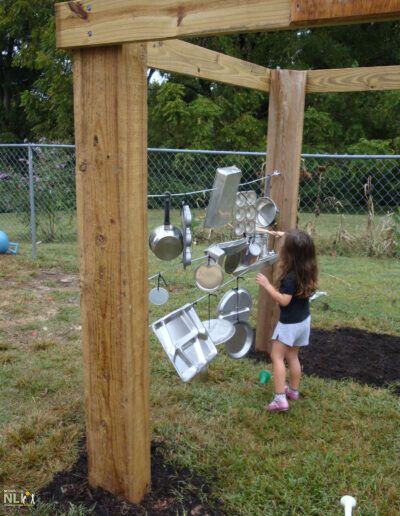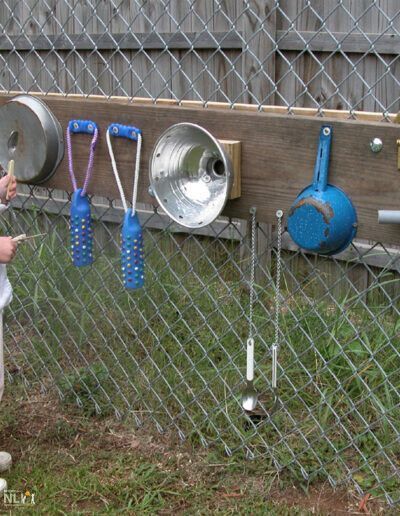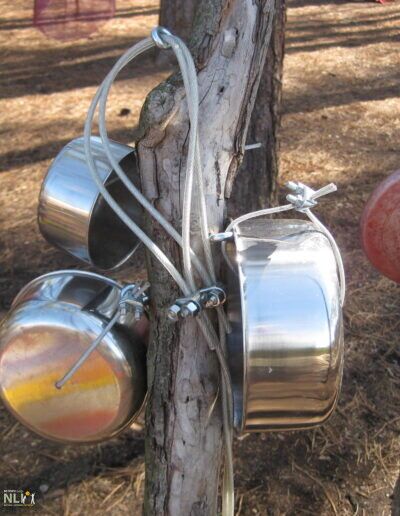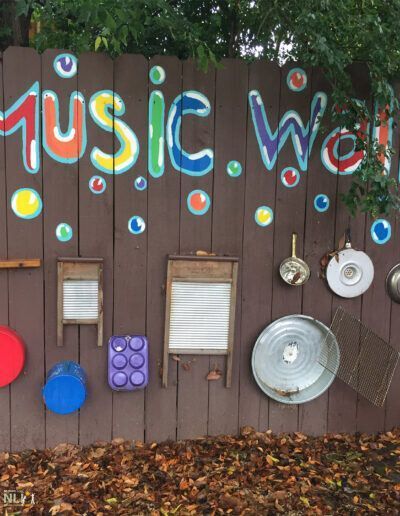Infosheets
17. Acoustic Play Settings
Acoustic play settings provide opportunities for “making music” and enjoying beautiful sounds. Settings can be created from recycled/re-purposed items such as pots, pans, and pipes, or manufactured items including drums, cymbals, xylophones, gongs, bells, and rattles mounted on a fence or structure designed for children to engage in percussive play. Settings include hand-held implements (drumsticks, spoons, etc.) to “play” the instruments. May be installed on a Deck, beside a Pathway, or on a Fence.
MATERIALS
Sound-making objects can be found in local second-hand stores, a nearby kitchen, or right in the classroom. Bells, chimes, pots, pans, and PVC pipes are commonly used for acoustic play settings. Options for noise-makers are endless. Re-purposed and recycled objects can be given playful new uses—get creative by testing the sounds of everyday household items. Provide sticks, spoons, and spatulas to create “drumsticks” or “strikers.”
location
When choosing an acoustic play location, remember that children will have the opportunity to make different sounds at various volume levels—sometimes acoustic play can be very loud. Consider locations where noise will not bother neighbors or adjacent classrooms.
structure
Sound-making instruments can be supported on a fence, a post, the side of a shed, or a secured wooden pallet (Figure 1). Free standing structures created using posts (Figure 2), trees, or prefabricated materials allow children to access acoustic play from several angles, encouraging social play. Be sure that the selected structure can support the weight of instruments. Carefully consider how objects will be attached.
hanging musical instruments
Secure sound-making instruments with outdoor quality zip-ties, cords, cables (Figure 2), screws, and brackets. Make sure that once attached, each object still makes a clear sound when played and does not clang against adjacent items. Physical separators may be needed. Keep in mind that instruments will be banged and tugged by children—for their safety, regularly inspect the acoustic play setting for loose or broken parts.
SECURING STRIKERS
Strikers are crucial for acoustic play. Found and recycled items such as prepared hardwood sticks, spoons, and spatulas work well for making a variety of sounds. Consider how strikers will be stored or accessed by children to encourage independent play, but also recognize possible “migration” around the play and learning space. Buckets for storing strikers near the acoustic play setting give children ready access but require time to collect misplaced strikers at the end of the day. Best practice is to tether strikers using light gauge chain and a clasp, eye hook, or screw (Figure 3). This method will work best with “hard” strikers that have existing holes in their handles, such as ladles or serving spoons.
PROVIDING SHADE
Providing shade to protect children and instruments from rain and sun is critical. Consider placing acoustic play settings in the shade of existing trees. Otherwise, use alternative shade structures such as pergolas, shade sails, or umbrellas.
CONSIDERING MANUFACTURED INSTRUMENTS
For centers focused on music and movement beyond informal play, well-designed outdoor instruments have become commercially available in recent years, installable as stand-alone, inclusive, covered music settings (see links below). As this is a more expensive option, carefully evaluate musical quality, sturdiness of construction, striker design and tethering, maintenance requirements, and diversity of instruments available. Check online reviews. Consider percussion instruments tuned to the five-note pentatonic scale. This is the most inclusive option as prior skill is unnecessary for making pleasant, improvised music. If local talent can help, create a Western version of the pentatonic Javanese”gamelan orchestra.” Hangdrums may also inspire appropriate equivalents for young children.
Materials & Tools
- Pots, pans, and lids
- Chimes and bells
- Bottles filled with dry beans
- Sticks, spoons, and spatulas to use as drumsticks
- PVC pipes cut to different lengths
- Industrial zip ties, screws, mounts, or brackets
- Outdoor musical instruments
- Fence, pallet, or wooden structure
Resources
- Percussion Play: www.percussionplay.com
- Freenotes Harmony Park: www.freenotesharmonypark.com
- Bobby McFerrin – from Notes and Neurons, The Pentatonic Scale: www.youtube.com/watch?v=ne6tB2KiZuk
- Space City Gamelan: www.youtube.com/watch?v=ioeVkPBvU2E
- Steel drums: www.youtube.com/watch?v=KrxQEQC0MaU
- Hangdrums: www.youtube.com/watch?v=xk3BvNLeNgw





